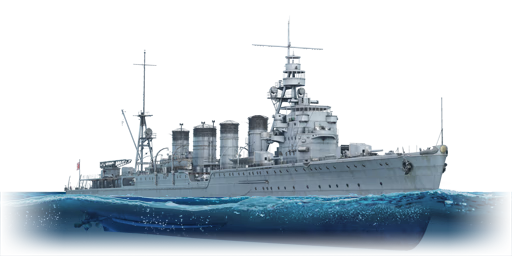

Bluewater Fleet
IJN Sendai
III
Rank
AB
5.0
RB
5.0
Battle rating
Japan
Research country
Light cruiser
Main role
25,000

Research
87,000

Purchase
General information
Specification
Armour
Citadel
0 / 63 / 29 mm
Main fire tower
38 / 8 / 0 mm
Hull
25 mm (steel)
Superstructure
13 mm (steel)
Number of sections
8
Displacement
7,180 t
Crew
450 persons
Max speed
Forward
65567656 km/h
Backward
25222922 km/h
Primary armament
7 × Turret — 140 mm/50 3rd Year Type cannon
Ammunition
1,400 rounds
Reload
basic crew → aces
7.8 → 6 s
Vertical guidance
-7 / 30°
Turret Rotation Speed
Horizontal
86.886.8 °/s
Vertical
86.886.8 °/s
| Ammunition | Type | Armor penetration (mm) at a distance: | |||||
|---|---|---|---|---|---|---|---|
| 1000 m | 2500 m | 5000 m | 7500 m | 10000 m | 15000 m | ||
| HE | 35 | 35 | 35 | 35 | 35 | 35 | |
| SAP | 86 | 75 | 59 | 46 | 37 | 35 | |
| HE-TF | 35 | 35 | 35 | 35 | 35 | 35 | |
| SAPBC | 116 | 102 | 81 | 64 | 50 | 33 | |
Secondary armament
2 × Turret — 2 × 25 mm/60 Type 96 automatic cannon
Ammunition
6,000 rounds
Belt capacity
15 rounds
Reload
basic crew → aces
2.6 → 2 s
Fire rate
261 shots/min
Vertical guidance
-10 / 85°
Turret Rotation Speed
Horizontal
1311.11311.1 °/s
Vertical
97.797.7 °/s
| Belt | Belt filling | Armor penetration (mm) at a distance: | |||||
|---|---|---|---|---|---|---|---|
| 10 m | 100 m | 500 m | 1000 m | 1500 m | 2000 m | ||
| HEF-T/HEF/AP-T/HEI | 55 | 53 | 44 | 37 | 32 | 29 | |
| AP-T/AP-T/AP-T/HEF | 55 | 53 | 44 | 37 | 32 | 29 | |
| HEF-T/HEI/HEI/HEI | 5 | 5 | 4 | 4 | 4 | 4 | |
Anti-aircraft armament
4 × 13.2 mm Type 93 machine gun
Ammunition
6,000 rounds
Belt capacity
30 rounds
Reload
basic crew → aces
2.6 → 2 s
Fire rate
476 shots/min
Vertical guidance
-15 / 85°
Turret Rotation Speed
Horizontal
1311.11311.1 °/s
Vertical
97.797.7 °/s
| Belt | Belt filling | Armor penetration (mm) at a distance: | |||||
|---|---|---|---|---|---|---|---|
| 10 m | 100 m | 500 m | 1000 m | 1500 m | 2000 m | ||
| T/AP/IAI/AP | 28 | 27 | 24 | 21 | 19 | 17 | |
2 × Turret — 7.7 mm Type 92 machine gun
Ammunition
3,880 rounds
Belt capacity
97 rounds
Reload
basic crew → aces
3.9 → 3 s
Fire rate
600 shots/min
Vertical guidance
-10 / 60°
Turret Rotation Speed
Horizontal
7563.87563.8 °/s
Vertical
7563.87563.8 °/s
| Belt | Belt filling | Armor penetration (mm) at a distance: | |||||
|---|---|---|---|---|---|---|---|
| 10 m | 100 m | 500 m | 1000 m | 1500 m | 2000 m | ||
| AP/T | 10 | 9 | 8 | 7 | 6 | 5 | |
Additional armament
Setup 1
16 × 610 mm Type 8 No.2 wet-heater torpedo
Setup 2
8 × Type 95 depth charge
Setup 3
16 × 610 mm Type 8 No.2 wet-heater torpedo
8 × Type 95 depth charge
8 × Type 95 depth charge
Economy
Repair cost
Basic → Reference
AB
5,834 → 7,911 

RB
6,849 → 9,287 

Crew training
25,000 

Experts
87,000 

Aces
700 

Research Aces
390,000 

Reward multiplier
AB / RB
360 / 600 % 

154 % 

Total cost of modifications
24,330 

49,000 

Talisman cost
1,300 

Seakeeping |
|---|
Unsinkability | |
|---|---|
Firepower | ||
|---|---|---|
Rating by players
You must play more than 3 battles for the last week and more than 10 battles in a vehicle to rate it.
Like:
4
Armor protection:
Not enough ratings
Survivability:
Not enough ratings
Mobility:
Not enough ratings
Armament:
Not enough ratings
Balance:
Not enough ratings
Tips & Tricks
This space is currently empty
Do you know any interesting vehicle features?
Loading...
No articles about this vehicle yet
Become the first author and get rewards!
Write a guide, tell about interesting historical facts, make a tutorial or simply an interesting post.
No more content